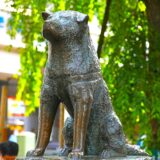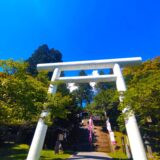目次
- 【Shinagawa Shrine summary】
- 【Shinagawa Shrine double-headed torii】
- 【Shinagawa Shrine mound covering reverently buried old fujis】
- 【Shinagawa Shrine precincts 】
- 【Shinagawa Shrine precincts Ana Inari Shrine】
- 【Shinagawa Shrine GOSHUIN】
- 【Shinagawa Shrine Nearby attractions】
- 【Shinagawa Shrine Access】
- Manager’s Comments
- Shinagawa Shrine
【Shinagawa Shrine summary】
Shinagawa Shrine was founded in 1187. The shrine was originally dedicated to Amenohirinome-no-Mikoto for maritime traffic safety and the fulfillment of prayers. In 1600, when Ieyasu Tokugawa went to battle in Sekigahara, he visited the shrine to pray for victory. In 1868, Emperor Meiji designated ten shrines in Tokyo, including Shinagawa Shrine, as “associate imperial shrines” to pray for the safety of the new capital, Tokyo, and the prosperity of the nation. (Tokyo Ten Shrines)
The three deities are Amenohirinomi-no-mikoto, Ugano-no-mikoto, and Susano-no-mikoto.
【Shinagawa Shrine double-headed torii】
![Shinagawa Shrine [Tokyo] DSC 0627 1024x768 - Shinagawa Shrine [Tokyo]](https://japan-shrine.info/wp-content/uploads/DSC_0627-1024x768.jpg)
The torii gate of Shinagawa Shrine, built in 1925 during the Taisho era (1912-1926), is a rare torii gate with a climbing dragon and a descending dragon carved on two pillars. The Shinagawa Shrine, Mabashi Inari Shrine, and the Inari Shrine on the grounds of Shukuhozan Koenji Temple (both in Suginami Ward) are the only shrines in Japan to have this twin dragon torii, and are known as the “Three Torii of Tokyo.
![Shinagawa Shrine [Tokyo] DSC 0647 2 1024x768 - Shinagawa Shrine [Tokyo]](https://japan-shrine.info/wp-content/uploads/DSC_0647-2-1024x768.jpg)
Seen from behind the torii gate, it looks like a dragon entwined with it. It is now designated as a cultural asset by Shinagawa Ward.
【Shinagawa Shrine mound covering reverently buried old fujis】
![Shinagawa Shrine [Tokyo] DSC 0628 1024x768 - Shinagawa Shrine [Tokyo]](https://japan-shrine.info/wp-content/uploads/DSC_0628-1024x768.jpg)
A little further up the stone steps, on the left side, is one of the largest Fuji mounds in Tokyo. Incidentally, when the movie Shin Godzilla went north on Yatsuyama-dori, there is a drawing that served as a shelter for many residents, and this staircase seems to have been the filming location.
![Shinagawa Shrine [Tokyo] DSC 0645 1024x768 - Shinagawa Shrine [Tokyo]](https://japan-shrine.info/wp-content/uploads/DSC_0645-1024x768.jpg)
Fuji, built in 1869 (Meiji 2), is said to be one of the largest mounds in Tokyo. Fuji, and climbing the mound is said to bring the same benefits as climbing the real Mt. From the top of the mountain, you can look down on the Keikyu Line and National Route 15.
There are Fuji mounds like this all over Japan, and in Tokyo there is one at Hatomori Hachiman Shrine and Gokokuji Temple.
【Shinagawa Shrine precincts 】
![Shinagawa Shrine [Tokyo] DSC 0644 2 1024x768 - Shinagawa Shrine [Tokyo]](https://japan-shrine.info/wp-content/uploads/DSC_0644-2-1024x768.jpg)
Climbing the sloping stairs, you will see a relatively small torii gate, which, according to what I have heard, is the second oldest torii gate in Tokyo. After passing through the torii gate, the main shrine of Shinagawa Shrine comes into view in front of you.
![Shinagawa Shrine [Tokyo] DSC 0637 1024x768 - Shinagawa Shrine [Tokyo]](https://japan-shrine.info/wp-content/uploads/DSC_0637-1024x768.jpg)
Although the shrine survived the war, it was restored in 2020 due to deterioration. Although it is located near Shinagawa Station, which is surrounded by high-rise apartment buildings, the view was better than I expected because it is located on a hill. It was a quiet and pleasant place covered with greenery.
【Shinagawa Shrine precincts Ana Inari Shrine】
![Shinagawa Shrine [Tokyo] DSC 0631 1024x768 - Shinagawa Shrine [Tokyo]](https://japan-shrine.info/wp-content/uploads/DSC_0631-1024x768.jpg)
Inari Shrine is located within the precincts of Shinagawa Shrine. Ana Inari Shrine (Ana Inari Shrine) is divided into an upper shrine and a lower shrine. The upper shrine enshrines “the spirit sent from heaven” and the lower shrine near the lower shrine enshrines “the spirit sent from heaven. There are not a thousand torii, but they are beautifully lined up in a row.
![Shinagawa Shrine [Tokyo] DSC 0640 1024x768 - Shinagawa Shrine [Tokyo]](https://japan-shrine.info/wp-content/uploads/DSC_0640-1024x768.jpg)
The Ana Inari Shrine (Shimo-sha) is hidden down a rather maze-like staircase.
![Shinagawa Shrine [Tokyo] DSC 0641 1 1024x768 - Shinagawa Shrine [Tokyo]](https://japan-shrine.info/wp-content/uploads/DSC_0641-1-1024x768.jpg)
It is said to be a popular power spot for money luck, and if you wash your money in the “Ichigumanbo no Goshinsui” (divine water) at the lower shrine of Ana Inari Shrine and spend it in the local shopping area, it will later come back to you ten thousand times. It was a little dimly lit and had a unique atmosphere.
【Shinagawa Shrine GOSHUIN】
![Shinagawa Shrine [Tokyo] 2024 08 11 22 52 Office Lens 718x1024 - Shinagawa Shrine [Tokyo]](https://japan-shrine.info/wp-content/uploads/2024_08_11-22_52-Office-Lens-718x1024.jpg)
【Shinagawa Shrine Nearby attractions】
Maxell Aqua Park Shinagawa
【Shinagawa Shrine Access】
Manager’s Comments
Although there are many cars driving on National Route 15 in front of the shrine, once you climb the stairs, you can leave the hustle and bustle behind and visit the shrine grounds in a more relaxed atmosphere. Although the surrounding area has now been developed, I believe that in the Edo period, the shrine had a superb view of the sea. It was a very quiet and nice shrine, even though it is located in the city.
3-7-15 Kita-Shinagawa, Shinagawa-ku, Tokyo 140-0001, Japan
※Parking lot for worshippers available
 Tour of Japanese shrines and temples
Tour of Japanese shrines and temples 

![Shinagawa Shrine [Tokyo] DSC 1218 520x300 - Shinagawa Shrine [Tokyo]](https://japan-shrine.info/wp-content/uploads/DSC_1218-520x300.jpg)
![Shinagawa Shrine [Tokyo] DSC 1773 520x300 - Shinagawa Shrine [Tokyo]](https://japan-shrine.info/wp-content/uploads/DSC_1773-520x300.jpg)
![Shinagawa Shrine [Tokyo] DSC 1876 2 150x150 - Shinagawa Shrine [Tokyo]](https://japan-shrine.info/wp-content/uploads/DSC_1876-2-150x150.jpg)
![Shinagawa Shrine [Tokyo] DSC 1218 150x150 - Shinagawa Shrine [Tokyo]](https://japan-shrine.info/wp-content/uploads/DSC_1218-150x150.jpg)
![Shinagawa Shrine [Tokyo] DSC 1803 150x150 - Shinagawa Shrine [Tokyo]](https://japan-shrine.info/wp-content/uploads/DSC_1803-150x150.jpg)
![Shinagawa Shrine [Tokyo] DSC 1773 150x150 - Shinagawa Shrine [Tokyo]](https://japan-shrine.info/wp-content/uploads/DSC_1773-150x150.jpg)

